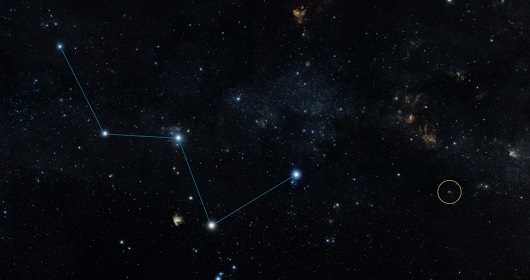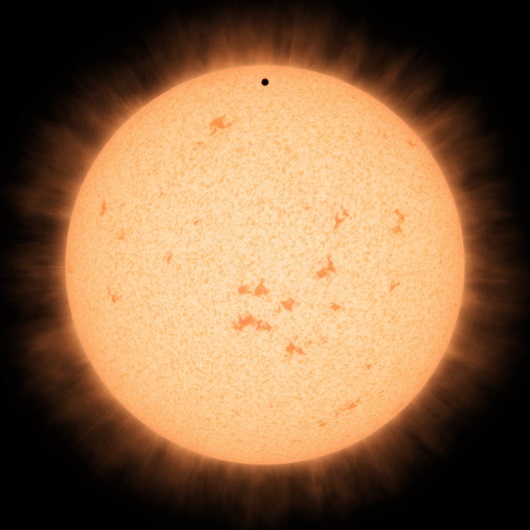Cassiopeia’s hidden gem

Astronomers from the University of St Andrews and the University of Edinburgh are among collaborators in a project which has today (Friday 31 July, 2015) announced the discovery of a new super-Earth.
Skygazers at northern latitudes are familiar with the W-shaped star pattern of Cassiopeia the Queen. This circumpolar constellation is visible year-round near the North Star. Tucked next to one leg of the W lies a modest 5th-magnitude star named HD 219134 that has been hiding a secret.
Astronomers have now teased out that secret: a planet in a 3-day orbit that transits, or crosses in front of its star. At a distance of just 21 light-years, it is by far the closest transiting planet to Earth. It is the nearest rocky planet confirmed outside our solar system. Its host star is visible to the unaided eye from dark skies, meaning anyone with a good star map can see this record-breaking system.
“Its proximity makes HD 219134 ideal for future studies. The James Webb Space Telescope and future large ground-based observatories are sure to point at it and examine it in detail,” said lead author Fatemeh (Ati) Motalebi of the Geneva Observatory.
The newfound world, designated HD 219134b, was discovered using the HARPS-North instrument on the 3.6-meter Telescopio Nazionale Galileo in the Canary Islands. The HARPS-North project is led by the University of Geneva, with the UK collaborators including the University of St Andrews, the University of Edinburgh and Queen’s University Belfast. Other partners are the Harvard-Smithsonian Center for Astrophysics and the Italian National Institute for Astrophysics (INAF).
The St Andrews and Edinburgh contributions were part-funded by the Scottish Funding Council through the Scottish Universities Physics Alliance. Together with funds from Queen’s University Belfast, these contributions funded construction of the telescope interface and instrument control systems at the Science and Technology Facilities Council’s UK Astronomy Technology Centre in Edinburgh.
HARPS-North detects planets using the radial velocity method, which allows astronomers to measure a planet’s mass. HD 219134b weighs 4.5 times the mass of Earth, making it a super-Earth.
With such a close orbit, researchers realized that there was good possibility the planet would transit its star.
Annelies Mortier of the University of St Andrews’ School of Physics and Astronomy said: “For a planet like this one, orbiting at a distance ten times the radius of its parent star, the chances of transits occurring are better than 1-in-10, so it was well worth looking.”
In April of this year the astronomers targeted the system with NASA’s Spitzer Space Telescope. At the appropriate time, the star dimmed slightly as the planet crossed the star’s face. Measuring the depth of the transit gave the planet’s size, which is 1.6 times Earth. As a result, the team can calculate the planet’s density, which works out to about 6 g/cm3. This shows that HD 219134b is a rocky world.

“It is really exciting that we are now starting to be able to determine the internal composition of such low-mass planets,” said Ken Rice from the University of Edinburgh.
What’s more, the team detected three additional planets in the system using radial velocity data. A planet weighing at least 2.7 times Earth orbits the star once every 6.8 days. A Neptune-like planet with nine times the mass of Earth circles in a 47-day orbit. And, much further out, a hefty fourth world 62 times Earth’s mass orbits at a distance of 2.1 astronomical units (200 million miles) with a ‘year’ of 1,190 days. Any of these planets might also transit the star, so the team plans to search for additional transits in the months ahead.
HD 219134 is an orange Type K star somewhat cooler, smaller and less massive than our Sun. Its key measurements have been pinned down very precisely, which allows a more precise determination of the properties of its accompanying planets.
This discovery came from the HARPS-North Rocky Planet Search, a dedicated survey examining about 50 nearby stars for signs of small planets. The team targeted nearby stars because those stars are brighter, which makes follow-up studies easier. In particular, additional observations might allow the detection and analysis of planetary atmospheres.
Dr Chris Watson, from the Astrophysics Research Centre at Queen’s, said: “The amount that we will learn about this planetary system when we train the world’s largest telescopes on it in the coming years will be phenomenal, and I’m sure there will be yet more surprises.”
HD 219134 was one of the closest stars in the sample, so it was particularly lucky to find that it hosts a transiting planet. This system now holds the record for the nearest transiting exoplanet. As such, it will likely be a favourite for researchers for years to come.
The paper describing this research has been accepted for publication in the journal Astronomy & Astrophysics.
Notes to news editors
Images are available from the University of St Andrews Press Office. Contact 01334 462 530 or email [email protected]
For more information, contact:
Dr Annelies Mortier, School of Physics and Astronomy, University of St Andrews (01334 463053; [email protected])
Professor Ken Rice, Institute for Astronomy, University of Edinburgh (0131 668 8384; [email protected])
Dr Christopher Watson, Astrophysics Research Centre, Queen’s University, Belfast (028 9097 3175; [email protected])
Dr Eric Lopez, Institute for Astronomy, University of Edinburgh (0131 668 8484; [email protected])
Category Research